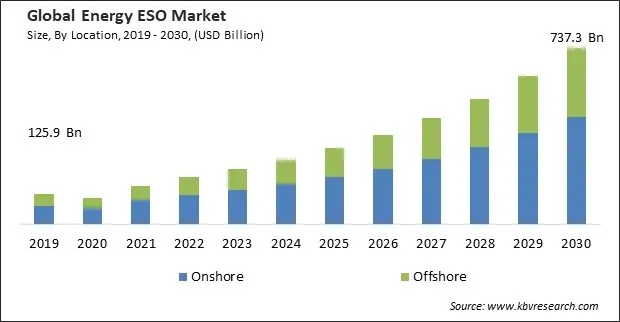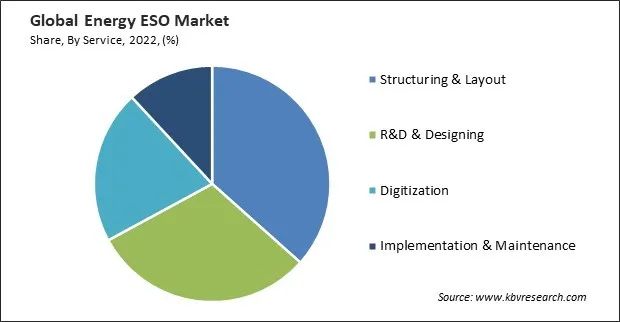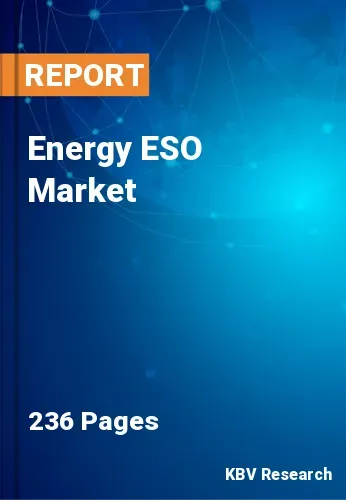The Global Energy ESO Market size is expected to reach $737.3 billion by 2030, rising at a market growth of 18.0% CAGR during the forecast period.
The liberalization of energy markets in Europe has facilitated the integration of renewable energy sources and the emergence of a more diverse and competitive energy landscape. This liberalization would propel the region to acquire nearly 25% for the total market share by 2030. Market liberalization encourages innovation, efficiency, and the adoption of advanced technologies in grid management. Europe has taken significant steps to increase the proportion of renewable energy in its energy matrix. Some of the factors impacting the market are increasing integration of renewable energy sources, growing adoption of smart grid technologies and grid complexity and aging infrastructure.

Renewable energy sources are often intermittent and dependent on weather conditions. These ESOs have the opportunity to develop and implement advanced grid management and balancing services to handle the variability of renewable generation. The rise of renewable energy presents an opportunity for the ESOs to invest in energy storage solutions, such as batteries. Furthermore, the need to accommodate renewable energy sources often drives investments in grid modernization. These ESOs can seize the opportunity to upgrade and modernize the grid infrastructure. These factors will help expand the market in the coming years. Additionally, Smart grid technologies provide the ESOs with real-time visibility into the status and performance of the electricity grid. Advanced sensors, smart meters, and monitoring devices enable continuous monitoring of grid parameters, such as voltage, current, and power quality. This real-time data allows these ESOs to detect abnormalities and respond promptly to disturbances. Moreover, smart grid technologies facilitate the implementation of demand response programs. These ESOs can communicate with smart meters and connected devices to adjust electricity consumption in response to grid conditions. This enables better peak demand management. These aspects will drive the demand in the market.
However, Wind and solar energy are renewable sources that are inherently intermittent and variable. Unlike traditional power plants that can be dispatched as needed, renewable generation depends on weather conditions. These ESOs need to adapt to the fluctuations in power output and manage the balance between supply and demand in real time. Moreover, aging infrastructure may not be designed to withstand the stresses and demands of the modern grid. The integration of new technologies introduces additional points of failure and potential vulnerabilities. Additionally, the increased connectivity of grid components enhances the risk of cyber threats. These aspects will limit the growth of the market in the upcoming years.
Based on service, the market is segmented into R&D & designing, structuring & layout, digitization, and implementation & maintenance. In 2022, the digitization segment garnered a significant revenue share in the market. Sensor networks and the Internet of Things (IoT) are crucial to digitization. The ESOs can gather up-to-date information regarding electricity flows, equipment functionality, and environmental circumstances by implementing sensors throughout the grid infrastructure. For predictive maintenance and well-informed decision-making, this information is vital. These ESOs can leverage the capabilities of advanced data analytics and artificial intelligence through digitization. Therefore, the segment will expand rapidly in the upcoming years.

On the basis of location, the market is divided into onshore and offshore. In 2022, the offshore segment witnessed a substantial revenue share in the market. Governments and international entities are increasingly setting ambitious renewable energy targets and climate goals to mitigate the impacts of climate change. As a clean and abundant energy source, offshore wind plays a pivotal role in helping countries achieve these targets, driving investments in the offshore segment. Ongoing advancements in offshore wind turbine technology, foundation design, and installation techniques have significantly improved the efficiency and cost-effectiveness of offshore wind farms. These aspects will pose lucrative growth prospects in the segment.
Based on source, the market is divided into renewable, non-renewable, and chemical processing. In 2022, the renewable segment witnessed a substantial revenue share in the market. Favorable policies and regulatory frameworks, such as renewable energy targets, feed-in tariffs, and incentives, incentivize deploying renewable energy projects. These ESOs maintain grid stability and dependability while collaborating closely with policymakers to ensure the seamless integration of renewable energy into the grid. These factors will lead to increased growth in the segment.
| Report Attribute | Details |
|---|---|
| Market size value in 2022 | USD 198.2 Billion |
| Market size forecast in 2030 | USD 737.3 Billion |
| Base Year | 2022 |
| Historical Period | 2019 to 2021 |
| Forecast Period | 2023 to 2030 |
| Revenue Growth Rate | CAGR of 18% from 2023 to 2030 |
| Number of Pages | 236 |
| Number of Tables | 350 |
| Report coverage | Market Trends, Revenue Estimation and Forecast, Segmentation Analysis, Regional and Country Breakdown, Porter’s 5 Forces Analysis, Company Profiling, Companies Strategic Developments, SWOT Analysis, Winning Imperatives |
| Segments covered | Location, Source, Service, Region |
| Country scope |
|
| Companies Included | Semcon AB (Ratos AB), Assystem S.A, Segula Holding, Quest Global Services Pte. Ltd, Mott MacDonald Group Limited, Luxoft Holding, Inc, (DXC TECHNOLOGY COMPANY), ESI Group, Cyient Limited, ALTEN and Altair Engineering, Inc. |
| Growth Drivers |
|
| Restraints |
|
By region, the market is segmented into North America, Europe, Asia Pacific, and LAMEA. The Asia Pacific segment procured the highest revenue share in the market in 2022. The Asia Pacific region is characterized by rapid economic development and urbanization, leading to a significant increase in energy consumption. As countries in the region strive for industrialization and improved living standards, the electricity demand continues to surge. Many Asia Pacific countries prioritize electrifying various sectors, including transportation, manufacturing, and services. This push towards electrification drives the demand for advanced ESO solutions. Therefore, the segment will expand rapidly in the coming years.
Free Valuable Insights: Global Energy ESO Market size to reach USD 737.3 Billion by 2030
The market research report covers the analysis of key stake holders of the market. Key companies profiled in the report include Semcon AB (Ratos AB), Assystem S.A, Segula Holding, Quest Global Services Pte. Ltd, Mott MacDonald Group Limited, Luxoft Holding, Inc, (DXC TECHNOLOGY COMPANY), ESI Group, Cyient Limited, ALTEN and Altair Engineering, Inc.
By Location
By Source
By Service
By Geography


This Market size is expected to reach $737.3 billion by 2030.
Increasing integration of renewable energy sources are driving the Market in coming years, however, Grid complexity and aging infrastructure restraints the growth of the Market.
Semcon AB (Ratos AB), Assystem S.A, Segula Holding, Quest Global Services Pte. Ltd, Mott MacDonald Group Limited, Luxoft Holding, Inc, (DXC TECHNOLOGY COMPANY), ESI Group, Cyient Limited, ALTEN and Altair Engineering, Inc.
The expected CAGR of this Market is 18.0% from 2023 to 2030.
The Non-renewable segment led the Market by Source in 2022; thereby, achieving a market value of $373.4 Billion by 2030.
The Asia Pacific region dominated the Market by Region in 2022, and would continue to be a dominant market till 2030; thereby, achieving a market value of $282.6 billion by 2030.
Our team of dedicated experts can provide you with attractive expansion opportunities for your business.

